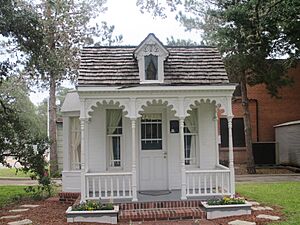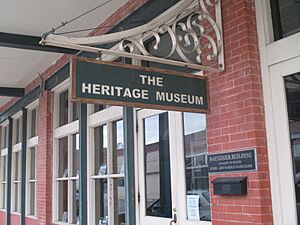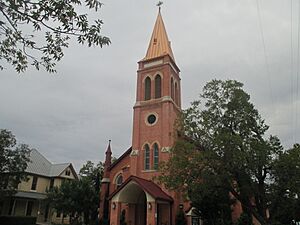Seguin, Texas facts for kids
Quick facts for kids
Seguin, Texas
|
|
|---|---|
|
Park Plaza Hotel, Seguin's tallest downtown building. Bottom: The 1916 Aumont Hotel is part of the National Register of Historic Places; the 2nd-tallest building in downtown Seguin.
|
|
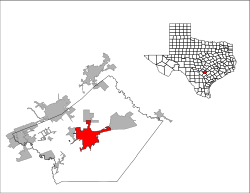
Location of Seguin in Guadalupe County, Texas
|
|
| Country | United States |
| State | Texas |
| County | Guadalupe |
| Founded | August 12, 1838 |
| Incorporated | 1853 |
| Government | |
| • Type | Council-Manager |
| Area | |
| • Total | 40.224 sq mi (104.180 km2) |
| • Land | 40.026 sq mi (103.666 km2) |
| • Water | 0.198 sq mi (51.157 km2) |
| Elevation | 558 ft (170 m) |
| Population
(2020)
|
|
| • Total | 29,433 |
| • Estimate
(2023)
|
36,013 |
| • Rank | TX: 102nd |
| • Density | 900.0/sq mi (347.4/km2) |
| Time zone | UTC–6 (Central (CST)) |
| • Summer (DST) | UTC–5 (CDT) |
| ZIP Codes |
78155, 78156
|
| Area code(s) | 830 |
| FIPS code | 48-66644 |
| GNIS feature ID | 2411860 |
| Sales tax | 8.25% |
Seguin (/sɪˈɡiːn/ sih-GHEEN) is a city in Guadalupe County, Texas, United States. It is also the county seat, meaning it is the center of the county government. In 2020, about 29,433 people lived there. By 2023, the population was estimated to be around 36,013.
Seguin is one of the oldest towns in Texas. It was founded just 16 months after the Texas Revolution began. The city is named after Juan Seguín, a Tejano (a Texan of Mexican heritage) who fought for Texas's freedom. The area was once a base camp for the famous Texas Rangers.
Discover Seguin, Texas
Seguin's economy mainly relies on a local hospital. It also has a water utility that supplies water to the Greater San Antonio area. This water comes from underground water sources called aquifers. The main office for the Guadalupe-Blanco River Authority, which manages dams in the area, is in downtown Seguin.
A Look at Seguin's Past
Seguin was home to Dr. John E. Park. He experimented with building using concrete made from local materials. Many buildings, like the courthouse, schools, and homes, were made this way. Seguin had the most 19th-century concrete buildings in the U.S. About 20 of them are still standing today.
The use of concrete slowed down when the railroad arrived in 1876. The railroad brought cheaper wood and tools for making bricks. Downtown Seguin's wooden buildings were replaced with brick by the time World War I started.
For nearly 100 years, Seguin depended on its rich farmland and ranches. Then, the Texas oil boom happened. This helped the town even during the Great Depression. To celebrate its 100th birthday, Seguin opened Max Starcke Park. This park had a golf course, picnic areas, and a beautiful waterfall created by a curving dam.
Seguin became one of the first "Main Street" cities in Texas. This program helps preserve historic downtown areas. The downtown area is now on the National Register of Historic Places. Many beautiful old homes designed by famous architects can be found on Seguin's streets.
After World War II, new industries came to Seguin. A small factory turned scrap metal into building materials. Later, Motorola built a plant for car electronics. This plant is now Vitesco Technologies and is Seguin's largest employer. Caterpillar also opened a diesel engine plant in 2008.
Ancient History of the Seguin Area
Long ago, the Seguin area was home to Native Americans. These were hunter-gatherers who lived in Texas. Archeologists have found old campsites here, some dating back about 10,000 years. They found trade items from Mexico and Arizona.
Early visitors might have come to collect pecans. Pecan trees grow well along the Guadalupe River. When the first European explorers arrived, the Tonkawa people mostly lived here. They camped near the Guadalupe and other streams. Later, Spanish, Mexican, and Anglo settlers started farms and ranches.
Early Settlers and the Town's Founding
José Antonio Navarro, an important figure in Texas history, had a ranch near Seguin. In 1831, the Mexican government gave land to Umphries Branch. The Branch and John Newton Sowell Sr. families settled here in 1833. They were among the first Anglo-Americans to grow corn in what would become Guadalupe County.
Between 1827 and 1835, 22 families came to the area as part of the Green DeWitt's colony. By 1833, 40 land titles were in the region. Many of these families had to leave their homes during the Runaway Scrape.
The town of Seguin was founded on August 12, 1838. This makes it one of the oldest towns in Texas. Members of Mathew Caldwell's Gonzales Rangers bought land that Umphries Branch had left. The Rangers found this spot to be a good halfway point for their patrols. It had been a base camp for them since the Dewitt Colony was first settled.
Seguin in the 1800s
Under a large oak tree, 33 Rangers signed the town's charter. Many of them were surveyors who helped plan the town's layout. Its first name was Walnut Springs. But just six months later, it was renamed Seguin. This honored Juan Seguín, a hero of the Battle of San Jacinto and a senator for the Republic of Texas.
The town's plan included a main north-south street. It also had a grid of streets around a central square. This square is now the Courthouse Square and Central Park.
A tree called the Whipping Oak stands near the courthouse. In the 1800s, criminals were sometimes tied to an iron ring on this tree and whipped as punishment.
Manuel N. Flores, a veteran of San Jacinto, had a ranch south of Seguin in 1838. This ranch became a safe place for families from San Antonio. It was also a meeting point for forces fighting against Santa Anna's army in 1842.
Texas Ranger John Coffee "Jack" Hays led the resistance from this location. Hays was a well-known resident of Seguin. In 1843, he set up a Ranger station here. He married Susan Calvert, whose father owned the Magnolia Hotel.
Two other famous Rangers, Henry and Ben McCulloch, served under Hays. Their home, "Hardscramble", is still standing. Colonel James Clinton Neill, who commanded the Alamo, is believed to be buried here.
Seguin became the county seat, and Guadalupe County was formed in 1845. This happened when Texas became a state. The town was officially incorporated in 1853. John D. Anderson became the first elected mayor.
German immigrants often stopped in Seguin on their way to settlements like New Braunfels. Many decided to buy land and settle around Seguin instead.
After Texas became a state, many settlers from the Old South arrived. They brought hundreds of enslaved people with them. These enslaved African Americans did most of the construction work in the town. This included building important concrete structures like Sebastopol House.
Education was important in Seguin. By 1849, a school was chartered. The first schoolhouse was built in 1850. This building, Guadalupe High School, is now part of St. James parochial school. It is recognized as the oldest continuously used school building in Texas.
Seguin was known as "the Mother of Concrete Cities" in the 1870s. It had nearly 100 buildings made of "limecrete" (concrete). This included the courthouse, schools, churches, and homes. So many concrete walls were built that Seguin looked like a walled city. About 20 of these old buildings still exist.
In 1857, Frederick Law Olmsted, who later designed New York's Central Park, visited Texas. He was amazed by the concrete buildings in Seguin. He called it "the prettiest town in Texas."
One surviving concrete home is the Sebastopol House. Built in 1856, it is a Texas Historical Commission landmark. It is also on the National Register of Historic Places because of its unique concrete construction.
Stagecoaches started serving Seguin in 1848. They connected coastal ports to San Antonio. The Magnolia Hotel was a stop for travelers. A young enslaved person would ring a bell to announce the stagecoach's arrival. This brought visitors, mail, and news to the town.
The historic Wilson Pottery site is near Seguin. This pottery was the first successful business in Texas owned by formerly enslaved people. It started in 1869.
During Reconstruction, formerly enslaved people in Seguin formed their own church, the Second Baptist Church. In 1876, they started a school called Lincoln School. In 1887, they founded Guadalupe College. This college focused on job training.
The railroad reached Seguin in 1876. It was part of the oldest railway in Texas. This railway is now part of the Union Pacific line.
John Ireland was mayor of Seguin in 1858. He later became the 18th Governor of Texas. He played a key role in building the Texas State Capitol. He insisted on using local red granite stone.
Seguin in the 1900s
From before the Civil War until World War II, cotton was a major crop. The county had many cotton gins. But farming in Seguin was diverse. Farmers also grew corn, peanuts, and raised hogs and cattle. Pecans were a very important crop. Seguin was one of the first counties to have a pecan growers' association. It is still a top producer of pecans in Texas. Seguin has been called "a big orchard with a small town in it." A large concrete pecan sculpture sits on the courthouse lawn.
Small mills were built on the Guadalupe River even before the Civil War. William Saffold built a mill at what is now Max Starcke Park. Later, Henry Troell improved it and used water power to light the town in 1894. The city took over the dam and power plant in 1907. Cheap electricity helped many businesses, like gins, mills, and ice plants.
In 1912, citizens of Seguin convinced a struggling church school to move to the city. They offered money and land. This school grew into Texas Lutheran University. Today, it has about 1,400 students and is highly ranked.
During the 1920s, the county began to see signs of an oil boom. In December 1929, the Darst Creek Field opened just 15 miles east of Seguin. Seguin became a supply center for oil workers. Residents could rent rooms for cash, even during the Great Depression.
Because of the oil money, Seguin could collect taxes when other towns struggled. The city used this money to get federal grants for projects. Under Mayor Max Starcke, Seguin was transformed. It got a new post office, a new Art Deco City Hall, and a new courthouse. New sidewalks and a park along Walnut Branch were also built.
Max Starcke's biggest achievement was a large park along the Guadalupe River. It was designed by Robert H.H. Hugman, who also designed the River Walk. The park had a recreation building, a swimming pool, and a golf course. It also had picnic areas and a beautiful waterfall. The town named the park after its popular mayor.
After World War II, new factories came to Seguin. These included a steel minimill, a company making roadside mowing equipment, and Continental Automotive Systems (formerly Motorola). Caterpillar opened a diesel engine plant in 2009.
Seguin's Location and Climate
Seguin is in the center of Guadalupe County. It is about 35 miles east of San Antonio on Interstate 10. It is also about 50 miles south of Austin.
The city covers about 40 square miles. Most of this is land, with a small amount of water. The Guadalupe River flows through the southern part of the city. It eventually reaches the Gulf of Mexico.
Weather in Seguin
Seguin is on the northern edge of the South Texas Plains. It has mild winters. Spring brings beautiful wildflowers from March to June. Summers are very hot and humid, from June to September. In October, cold fronts often bring rain and a "second spring" of wildflowers. In fall and winter, "northers" can bring fast-moving cold fronts. These cause winds, rain, and quick drops in temperature. However, warm spells often follow these cold fronts, even in winter.
People of Seguin
| Historical population | |||
|---|---|---|---|
| Census | Pop. | %± | |
| 1860 | 792 | — | |
| 1870 | 830 | 4.8% | |
| 1880 | 1,363 | 64.2% | |
| 1890 | 1,716 | 25.9% | |
| 1900 | 2,421 | 41.1% | |
| 1910 | 3,116 | 28.7% | |
| 1920 | 3,631 | 16.5% | |
| 1930 | 5,225 | 43.9% | |
| 1940 | 7,006 | 34.1% | |
| 1950 | 9,733 | 38.9% | |
| 1960 | 14,299 | 46.9% | |
| 1970 | 15,934 | 11.4% | |
| 1980 | 17,854 | 12.0% | |
| 1990 | 18,692 | 4.7% | |
| 2000 | 22,011 | 17.8% | |
| 2010 | 25,175 | 14.4% | |
| 2020 | 29,433 | 16.9% | |
| 2023 (est.) | 36,013 | 43.1% | |
| U.S. Decennial Census Texas Almanac: 1850-2000 2020 Census |
|||
In 2020, Seguin had 29,433 people. There were 10,542 households. About 53.74% of the population was Hispanic or Latino. About 36.47% were White (non-Hispanic). About 5.93% were Black or African American (non-Hispanic).
About 21.7% of residents were under 18 years old. About 16.9% were 65 or older. The average age was 35.3 years.
Getting Around Seguin
- Austin-Bergstrom International Airport is about an hour away.
- San Antonio International Airport is 45 minutes to an hour away.
- Huber Airpark is a private airport for small planes.
Greyhound offers daily bus service to Houston and San Antonio. Tri City Taxi Service is based in Seguin.
Major Roads and Routes
 Interstate 10: Connects Seguin to Houston, San Antonio, and El Paso.
Interstate 10: Connects Seguin to Houston, San Antonio, and El Paso. US Highway 90: Runs through Seguin, connecting to San Antonio.
US Highway 90: Runs through Seguin, connecting to San Antonio.
 Alt. US 90: Connects Seguin to Houston.
Alt. US 90: Connects Seguin to Houston. State Highway 46: Goes from Seguin to New Braunfels.
State Highway 46: Goes from Seguin to New Braunfels. State Highway 123: Connects San Marcos, Seguin, and Karnes City.
State Highway 123: Connects San Marcos, Seguin, and Karnes City. State Highway 130 (Toll Road): A toll road connecting Austin to I-10 at Seguin.
State Highway 130 (Toll Road): A toll road connecting Austin to I-10 at Seguin. FM 78: Connects Seguin to nearby towns like Schertz.
FM 78: Connects Seguin to nearby towns like Schertz. FM 20: Connects Seguin to Lockhart.
FM 20: Connects Seguin to Lockhart. FM 466: Goes from Seguin to Gonzales.
FM 466: Goes from Seguin to Gonzales.
Culture and Fun in Seguin
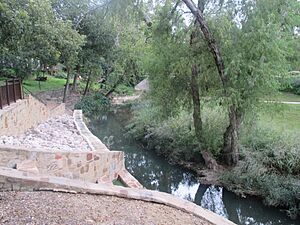
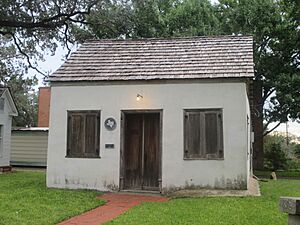
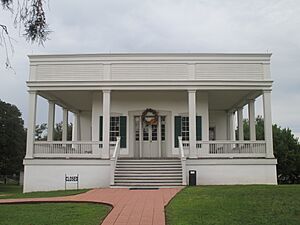
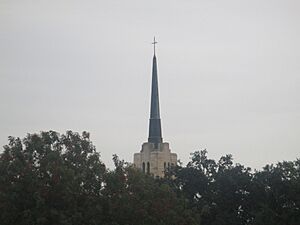
Local News and Radio
Seguin is one of the few cities with two daily newspapers. The Gazette has been publishing since 1888. The Daily News is part of the local radio station KWED.
- Seguin Gazette
- Seguin Daily News
- KWED 1580 AM
Fun Things to Do in Seguin
- ZDT's Amusement Park: This family-owned park has many attractions. It uses old farm buildings for fun activities. You can climb silos, ride go-karts on a warehouse roof, and enjoy a wooden roller coaster called Switchback.
- Texas Agricultural Education and Heritage Center: Also known as the "Big Red Barn," this center teaches about farming history. It has sample crops, farm animals, and old equipment. There's also a collected village with old houses, a schoolhouse, and a blacksmith shop.
- Sebastopol House Historic Site: This is a beautiful 19th-century concrete building. It was built by enslaved people using local materials. It's now a museum that offers free tours.
- Fiedler Museum: This museum on the TLU campus displays different types of rocks from Texas.
- "The World's Largest Pecan": This is a 5-foot-long concrete pecan on the courthouse lawn. Seguin is known as the "Pecan Capital of Texas." A new, even larger pecan sculpture was unveiled in 2011 at the Texas Agricultural Education and Heritage Center.
- True Women: Seguin is a setting in this historical novel by Janice Woods Windle. The author grew up here and learned about women's history from her family. The book was made into a TV miniseries.
- Park West: This 47-acre park has athletic fields, a skatepark, a splash pad, and nature trails.
- Max Starcke Park: Enjoy a scenic drive along the Guadalupe River. The park has an 18-hole golf course, picnic areas, and sports courts. You can also canoe or kayak on the river.
- Seguin Events Complex/Fairgrounds Park: This is home to the Guadalupe County Fair & PRCA Rodeo. It has a rodeo arena, baseball fields, and volleyball courts.
- Walnut Springs Park: This park has trails, historic markers, and sculptures. It was once part of a stagecoach route.
- Central Park: Here you'll find a statue of Tejano hero Juan N. Seguín. The park hosts band concerts and car shows.
- Historic Main Street District: Take a walking tour to see beautiful early 20th-century buildings. They were designed by famous architects.
- Seguin Outdoor Learning Center
- Max Starcke Park Golf Course: An 18-hole course along the river.
- Golf Club of Seguin / Chaparral Golf Course
- Lake Seguin/Seguin Paddling Trail: Great for canoeing and kayaking.
- Meadow Lake: Good for fishing and boating.
- Lake Placid: Good for fishing, boating, and jet skiing.
- The Seguin River Monsters: A college summer baseball team that plays in the Texas Collegiate League.
Performing Arts
The Mid-Texas Symphony is the area's only professional orchestra. They perform classical and pop concerts. They also put on free concerts for fourth and fifth graders. The symphony was started in 1978 by Anita Windecker.
Teatro De Artes De Juan Seguin is a non-profit group. It promotes Mexican American culture through art. They offer classes and performances for youth and adults. They are home to the Ballet Folklórico De La Rosa and Mariachi Juan Seguin.
Public Art Around Seguin
- "The World's Largest Pecan": A popular art piece on the courthouse lawn.
- Eagle sculpture: On the Guadalupe County Veterans Memorial.
- "Stagecoach Road": A large mural showing the old stagecoach route.
- Statue of Juan N. Seguín: A hero-on-horseback statue in Central Park.
- Art Deco fountain: In Central Park, designed in the 1930s.
- Bas-reliefs: Sculptures of Justice and Wisdom on the courthouse.
- Bas-relief of the town seal: Above the City Hall entrance.
- Bird sculptures: Eight wood and metal works in Walnut Springs Park.
- Statue of Martin Luther: In front of Beck College Center at Texas Lutheran University.
- Three Graces Sculpture: On the TLU campus.
- Sculpture Garden: On the TLU campus, with works by various artists.
Historic Sites on the National Register
Guadalupe County has about a dozen sites on the National Register of Historic Places. Most are in Seguin:
- Sebastopol House (added 1970)
- Erskine-Holloman House (1970)
- Los Nogales (1972)
- Wilson Utility Pottery Kilns Archeological Dist. (1975)
- Joseph E. Johnson House (1978)
- Robert Hall House (1979)
- Saffold Dam (1979)
- Park Hotel, or Plaza Hotel (1980)
- Commercial Historic District (1983)
- Edward and Texana Tewes House (1997)
- Sweet Home Vocational and Agricultural High School (1998)
The county also has 80 Texas State Historical Markers. About 25 of these are within Seguin.
Sister Cities
Seguin has three sister cities:
 Millicent, South Australia, Australia
Millicent, South Australia, Australia Vechta, Lower Saxony, Germany
Vechta, Lower Saxony, Germany San Nicolás de los Garza, Nuevo León, Mexico
San Nicolás de los Garza, Nuevo León, Mexico
Famous People from Seguin
- Jacob De Cordova: Land agent and Texas politician.
- Manuel N. Flores: Rancher and Texas Revolution fighter.
- Drew French: Current bullpen coach for the Atlanta Braves baseball team.
- Nanci Griffith: Grammy Award-winning singer and songwriter.
- P.J. Hall: NFL defensive tackle.
- Chuck Hartenstein: MLB baseball pitcher and coach.
- John Coffee "Jack" Hays: Famous Texas Ranger.
- John Ireland: Governor of Texas.
- Ron Jones: MLB player for the Philadelphia Phillies.
- J. R. E. Lee: Born enslaved, later president of Florida A&M University.
- Shelley Mayfield: Professional golfer and course designer.
- Ben McCulloch: Confederate general.
- Henry McCulloch: Confederate general.
- Forrest Mims: Amateur scientist and author on electronics.
- José Antonio Navarro: Rancher and signer of the Texas Declaration of Independence.
- John Park: Inventor and builder using concrete.
- Freddie Patek: MLB shortstop for the Kansas City Royals.
- Max Starcke: Seguin mayor and head of the Lower Colorado River Authority.
- "Smokey" Joe Williams: Negro league baseball pitcher, in the Baseball Hall of Fame.
- Janice Woods Windle: Author of historical novels.
- Harry Wurzbach: Member of the U.S. House of Representatives.
See also
 In Spanish: Seguin (Texas) para niños
In Spanish: Seguin (Texas) para niños







